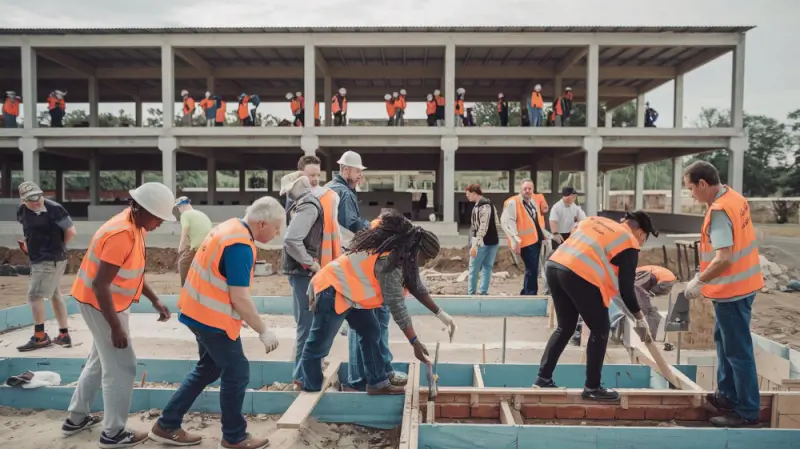Labor Supply Curve: Finding Construction Workers in 2025
Look, we're not going to sugarcoat this. If you're trying to staff a construction project right now, you're probably pulling your hair out. The industry needs 439,000 workers this year, and everyone's fighting over the same talent pool. But here's something most contractors don't get: throwing more money at the problem doesn't always fix it. Understanding the labor supply curve can save you thousands and actually get workers on your site.
What Is This Labor Supply Curve Thing Anyway?
Think of the labor supply curve as a simple truth: pay more, get more applicants. It's usually an upward line on a graph where wages go up the left side and number of workers goes across the bottom.
Here's what that looks like in real life. You post a job for $15/hour and get maybe 20 guys showing interest. Bump it to $22/hour and suddenly your phone's ringing off the hook with 50 people wanting in. That's the labor supply curve doing its thing.
But here's where it gets messy. Right now, there are 4.7 million more open jobs than people looking for work across America. So even when you raise wages, you're mostly just stealing workers from the guy down the street. You're not actually creating new workers.
Companies like FlexCrew USAget this. Instead of making you compete in a bidding war, they tap into networks of workers you'd never reach with a job posting. That's smarter than just jacking up wages and hoping.

How It Actually Works in Construction
In most markets, customers buy stuff and businesses sell it. Labor markets flip that around. Workers are selling their time, and you're buying it. Wages are the price.
Your graph puts wages on the vertical line and number of workers on the horizontal. Simple enough. But what makes that line move around? Let's break it down.
More People = More Workers (Usually)
Immigration is keeping construction alive right now. Nearly 25% of construction workers are immigrants, and in trades like framing and concrete, it's over 31%. When more people move into your area, that supply curve shifts right. More workers available at every wage level.
That's why FlexCrew USA doesn't just work in one city. Their network spans multiple states, so when your local market is tapped out, they pull from somewhere else. Pretty straightforward solution to a location problem.
Other Industries Stealing Your Workers
Remember 2021 and 2022 when restaurants and warehouses were offering sign-on bonuses like crazy? Construction companies couldn't compete. Workers left job sites for climate-controlled Amazon facilities. When other industries raise wages, your labor supply shrinks.
FlexCrew USA's AI Resume Builder helps workers see why construction is actually a better deal long-term. Better pay trajectory, skills that transfer, upward mobility. When workers understand the full picture, they're more likely to stick with construction even when Target is offering $18/hour.
Training Creates More Workers (Eventually)
The reason electricians make $35/hour and laborers make $18? Training barriers. It takes years to become a licensed electrician. That limited supply drives wages up.
But here's the smart play: FlexCrew USA keeps a database of certified workers who've already cleared those barriers. You're not waiting months for someone to get licensed. You're hiring someone who can start Monday.
Why Construction Labor Markets Are Broken Right Now
The job opening rate in construction dropped to 2.9% in July 2024. That's the lowest since COVID started. You'd think that means it's easier to find workers, right? Wrong.
The industry is basically at full employment for skilled workers. Everyone who wants a construction job has one. So when you post an opening, you're not getting unemployed workers. You're trying to poach someone else's crew.
Everyone's Getting Older
Women make up almost 11% of construction workers now, which is progress from 9% in 2017. But we're still pulling from too narrow a demographic, and that demographic is aging fast. The experienced guys are retiring, and there aren't enough young workers trained to replace them.
FlexCrew USA actively recruits women, veterans, and people switching careers. They're expanding the pool instead of fighting over the same 500 workers everyone else is chasing.
Your Job Site Is Too Far Away
Over 25% of companies say workers can't get to job sites. This isn't software development where you can work from your couch. You need bodies on site, swinging hammers and running equipment.
Some contractors run shuttles. Others just accept they'll have a smaller labor pool. FlexCrew USA's geographic matching puts you in touch with workers who already live near your project. No transportation headaches, no excuses.
States like Texas and Arizona have it worst. Big infrastructure projects suck up all the available workers, leaving smaller contractors scrambling.
When More Money Doesn't Mean More Workers
Here's something that trips up a lot of construction managers. At a certain point, raising wages actually gives you fewer hours worked. It's called a backward-bending labor supply curve, and it's real.
Picture your best superintendent. He's making $45/hour, working 50 hours a week. You offer him $67.50 for overtime on weekends. He turns you down. Why? Because he's already clearing six figures and he'd rather go to his kid's soccer games.
Once workers make enough money, they start valuing their time off more than additional cash. The income effect beats the substitution effect (fancy economics talk for "I'm good, thanks").
This is why wage wars don't always work. Your most experienced workers aren't chasing every extra dollar. They're chasing balance.
FlexCrew USA keeps relationships with workers at different life stages. Need someone hungry who wants 60-hour weeks? They've got recent trade school grads. Need a seasoned pro for 30-hour project management? They've got semi-retired guys who want to stay active but not kill themselves.
What This Means for Your Projects This Year
Let's talk money. The average construction wage jumped significantly over three years. General laborers who made $16/hour in 2021 are now pulling $22-24 in most markets. Skilled trades went up even more.
But just matching wages isn't enough anymore. You need to understand where workers are and where they're going.
Dallas might have 15 qualified electricians available right now. Houston might have 50. Semiconductor plants in Arizona are vacuuming up every available worker within 100 miles. Data centers in Virginia are doing the same thing.
What's Coming in 2025
Construction spending growth will be under 3% this year. That's the slowest in forever. High interest rates are crushing residential projects. Yet we still need 439,000 more workers because current projects are already short-staffed.
The hot sectors:
- Infrastructure (federal money flowing)
- Data centers (AI boom is real)
- Manufacturing plants (companies moving production back to the US)
- Solar and wind farms (renewable energy mandates)
Meanwhile, single-family homes and apartments are way down. That means some workers are available, but they're in the wrong place or wrong specialty.
FlexCrew USA tracks this stuff daily. When residential cools in Phoenix but data centers explode, they're already moving workers to where the demand is. You get access to workers before they even know they need a new gig.
Sector | Growth Rate | Worker Shortage | Wages |
|---|---|---|---|
Infrastructure | High | Critical | Up 8-12% |
Data Centers | Very High | Severe | Up 15%+ |
Residential | Low | Moderate | Flat |
Manufacturing | Moderate | Growing | Up 6-10% |
Renewables | High | Critical | Up 10-15% |
How to Actually Solve Your Staffing Problems
Stop thinking wages alone will save you. Here's what actually works.
Build Real Compensation Packages
Today's workers look at the whole deal:
- Sign-on bonuses ($1,000-5,000 for trades)
- Health insurance that doesn't suck
- Actual paid time off
- Tool allowances
- Clear path to move up

FlexCrew USA's AI Resume Builder matches workers to companies based on what they actually care about. A 35-year-old with kids might take $2/hour less for better healthcare. A 24-year-old might chase the highest rate. The system knows the difference and makes better matches.
Make It Easier to Get Started
The skilled trades shortage is real. Fix it by:
- Running paid apprenticeships
- Partnering with trade schools
- Fast-tracking training (2 years instead of 4)
- Teaching digital skills (everyone needs tech now)
FlexCrew USA works directly with training programs. You get first crack at newly certified workers before they hit the open market. You're not just filling jobs today, you're building your crew for next year.
Fish in Different Ponds
Stop competing for the same workers:
- Recruit military veterans (discipline, skills, show up on time)
- Target people leaving dead industries
- Hire more women (10.8% is pathetic)
- Offer flex schedules for parents and students
FlexCrew USA's database includes non-traditional workers who bring different perspectives. They've placed former retail managers who became excellent project coordinators. Military equipment operators transition perfectly to running excavators and cranes.
Stop Going It Alone
Real talk: the best workers aren't on Indeed or Craigslist. They're already working. Just not for you yet.
FlexCrew USA maintains relationships with over 50,000 construction workers across multiple states. When you need three welders in Atlanta by Monday, they're not posting ads. They're texting workers whose last project wrapped up last week.
What you get:
- Placement in 3-5 days instead of 3-5 weeks
- Pre-verified credentials and references
- Temp, temp-to-hire, or direct placement options
- Access to workers in nearby states
- AI matching that puts right skills in right jobs
Their AI Resume Builder works both ways. Workers showcase their real strengths while the system identifies companies that value those specific skills. Better matches mean people stick around longer.
Do These Five Things Today
- Check if your total package is competitive (not just wages)
- Figure out which jobs need faster training tracks
- Calculate what project delays cost you per day
- Call FlexCrew USA for a free labor market analysis
- Get your urgent positions into their AI matching system
Technology Is Changing Everything
Robots and automation are reducing the need for some manual labor. Bricklaying robots exist. Concrete pours itself now. Drones do surveying. You need fewer bodies for certain tasks.
But those technologies need operators who understand the tech. You're not just hiring muscle anymore. You need workers who can program, troubleshoot, and manage equipment. That creates new barriers for traditional workers who haven't upskilled.
FlexCrew USA's AI Resume Builder helps workers highlight their tech skills. An equipment operator who lists drone certification and GPS grading experience gets moved to the front of the line.
VR training programs are making skills development faster and cheaper. Heavy equipment simulators let workers practice without burning diesel or risking expensive mistakes. This lowers barriers and expands the worker pool.
Geography matters less now too. Not because construction is remote (it's not), but because better project management means workers can take 6-week assignments far from home without destroying their family life.
FlexCrew USA makes these arrangements work. They handle housing, travel, and per diem. A worker in Ohio can take a Tennessee gig if the math works. That expands your effective labor supply by hundreds of miles.
Regional Differences in Construction Labor Markets
Labor supply isn't uniform across America. Some states are drowning in unfilled positions while others have slightly more breathing room. Texas, Arizona, and Florida lead the pack in severe shortages due to booming construction activity. Infrastructure projects, semiconductor plants, and population growth create insane demand.
Georgia follows close behind with data center construction and manufacturing facilities sucking up every available worker. North Carolina sees mixed development growth straining local labor pools. Meanwhile, some Midwest and Northeast markets maintain slightly more slack, though "slack" is relative when the whole country needs workers.
Within states, the urban-rural divide matters too. Projects near major cities like Dallas, Phoenix, or Atlanta can tap into larger worker pools. Remote jobsites face transportation barriers that shrink the effective labor supply dramatically.
FlexCrew USA's interstate network becomes particularly valuable in tight markets. We've successfully moved Louisiana workers to Texas projects and Ohio workers to Pennsylvania jobs. The platform handles all the logistics—housing stipends, travel coordination, per diem calculations—that make interstate placements actually work. This effectively expands your labor supply by hundreds of miles instead of being limited to a 50-mile radius.
Understanding Supply vs Demand in Labor Markets
Let's clear up confusion between labor supply and labor demand because they're opposite sides of the same coin.
Labor supply represents workers willing to work at various wage levels. It's the employee side of the market. How many electricians are willing to work for $30/hour? How many for $40/hour? That's supply.
Labor demand represents how many workers companies want to hire at various wage levels. It's the employer side. How many electricians does your project need at $30/hour? How many could you use if they only cost $20/hour? That's demand.
The labor market reaches equilibrium when supply equals demand. The wage where the number of workers willing to work matches the number of jobs available becomes the market wage.
Currently, construction labor demand way exceeds supply by a massive margin. There are far more open positions than available workers at any wage level. This creates upward pressure on wages and makes filling positions incredibly difficult. Even if you match or beat market wages, you're mostly just shuffling workers between companies rather than accessing untapped labor pools.
How Different Factors Shift Your Available Labor Pool
Population changes create the most obvious shifts in labor supply. When working-age people move into your region, the supply curve shifts right—more workers available at every wage level. When people leave, it shifts left. Immigration policy directly impacts construction because nearly 25% of the workforce consists of immigrant workers, rising to over 31% in specific trades like framing and concrete work.
Competing wage opportunities in other industries also shift your supply. When restaurants, warehouses, or retail operations raise wages significantly, construction labor supply shrinks. Workers leave job sites for climate-controlled environments or steadier schedules. The 2021-2022 period demonstrated this perfectly when service industries offered aggressive sign-on bonuses and pulled workers away from construction.
Training programs and educational partnerships increase qualified worker supply over time. However, this effect takes years to materialize. You can't snap your fingers and create licensed electricians. Barriers to entry like certifications, apprenticeship requirements, and licensing create bottlenecks that restrict supply and drive up wages for qualified workers.
Working conditions and company reputation matter more than many contractors realize. Companies with strong safety records, clear advancement paths, and positive cultures attract more applicants at the same wage levels as competitors with poor reputations. Your effective labor supply increases when workers actually want to work for you.
Geographic factors create localized supply constraints. Transportation difficulties, childcare challenges, and housing costs all affect which workers can realistically take your jobs. Over 25% of construction companies report that potential employees struggle with transportation to jobsites.
FlexCrew USA tracks all these shifting factors across multiple markets in real-time. Our platform provides intelligence on where workers are moving, why they're moving, and what it takes to attract them. Instead of guessing about market conditions, you get data-driven insights that inform your staffing strategy.
The Skills Mismatch Problem Nobody Talks About
Here's a frustrating reality: even when unemployment exists in construction, it's often the wrong kind of workers for your needs. You might have available general laborers when you desperately need welders. Or you need heavy equipment operators certified on specific machinery that only 50 people in your state can legally operate.
Skills mismatches mean that the theoretical labor supply (total construction workers) doesn't match your practical labor supply (workers with the exact skills you need right now). This is why aggregate employment statistics can be misleading. The market might show available workers, but none of them can do what your project requires.
Licensing and certification requirements create these mismatches. An experienced carpenter can't just become an electrician next week. The barriers to entry that protect wages for skilled trades also restrict your ability to quickly fill specialized positions.
FlexCrew USA's pre-verified database solves this by maintaining detailed skill profiles. When you need three welders certified in structural steel, the AI doesn't return general welders. It returns workers with the specific certifications your project requires. This dramatically reduces the time from "we need someone" to "they're on site working."
Why Traditional Recruiting Fails in Tight Labor Markets
Job postings on Indeed or Craigslist made sense when unemployment was higher. Post a job, wait for applications, interview, hire. That model is broken now.
The best construction workers aren't unemployed and browsing job boards. They're already working—just not for you yet. They're finishing up a project across town or considering staying with their current employer. Traditional job postings never reach these workers.
Even when postings reach qualified workers, the timeline is too slow. You post Monday, applications trickle in through the week, you schedule interviews for next week, check references the week after, and make an offer three weeks from your initial need. Meanwhile, your project timeline is slipping and you're paying penalties.
Credential verification adds more delays. Is that welding certification real? Did he actually work at those previous companies? Can she operate that specific equipment model? You're doing detective work instead of building.
FlexCrew USA eliminates these delays entirely. We maintain active relationships with over 50,000 construction workers across multiple states. When you need workers, we're not posting ads and hoping. We're contacting people we've already vetted whose skills match your needs. Average placement time drops from 3-5 weeks to 3-5 days.
The platform handles all credential verification upfront. By the time you see a candidate profile, we've already confirmed certifications, checked references, and verified work history. You're reviewing qualified workers, not sorting through questionable applications.
Bottom Line
Understanding labor supply curves isn't academic nonsense. It's the foundation of your staffing strategy for 2025.
The supply is maxed out. With 439,000 workers needed and basically full employment, there's no secret reserve waiting to be discovered. Every hire is probably pulled from another company or another industry.
Wages alone won't fix it. The backward-bending curve means high earners might work less. And wage wars just inflate everyone's costs without creating more workers.
Smart strategies beat brute force. Winners are expanding recruiting pools, lowering barriers, offering complete packages, and partnering with staffing pros who understand local markets.
Technology helps. AI matching, virtual training, and better project management reshape the labor supply curve in your favor if you actually use it.
FlexCrew USA gives you an edge. While competitors waste weeks with job postings and unqualified applicants, you're getting texts from their network of pre-vetted pros ready to work. While they're fact-checking resumes, you're reviewing workers with verified track records.
Their AI Resume Builder creates better matches on both sides. Workers present skills that matter to employers. Companies see candidates who actually fit. Result: faster placements, better retention, fewer headaches.
Ready to stop fighting the labor supply curve? Partner with FlexCrew USA and access workers your competitors can't reach.
Visit flexcrewusa.com or call today for a free consultation on your 2025 staffing needs.
FAQs About Labor Supply Curves
What is the labor supply curve in simple terms?
It's a graph showing how many workers will work at different wages. Higher wages usually mean more workers. For construction, this means raising pay typically gets more applicants—but only if qualified workers exist in your market.
Why is construction's labor supply curve so tight in 2025?
We need 439,000 additional workers but the labor force is near full employment. Skilled workers are retiring faster than new ones get trained, immigration restrictions cut off traditional labor sources, and competing industries are grabbing available workers.
How do wages affect labor supply in construction?
Higher wages pull workers from other industries or bring non-working people into the job market. But the effect is limited by how many qualified workers exist total. In tight markets, you might raise wages 15-20% just to steal workers from competitors.
What causes the labor supply curve to shift?
Population changes, competing wages in other industries, training programs, licensing requirements, working conditions, company reputation, and geographic factors all shift the curve. When any of these change, your available labor pool changes.
Why can't I find workers even with higher wages?
You're hitting the wall of available qualified workers. When the market is near full employment, higher wages just shuffle workers between companies—they don't create new workers. Skills mismatches and the backward-bending curve also limit supply.
What is a backward-bending labor supply curve?
When wages get so high that workers choose leisure over more income. A superintendent earning $120K annually might skip overtime to spend weekends with family because he values free time more than extra money.
How does location affect construction labor supply?
Texas, Arizona, Florida, Georgia, and North Carolina have severe shortages. Some Midwest and Northeast markets have slightly more slack. Within states, urban projects access larger pools while remote sites struggle with transportation barriers.
What's the difference between labor supply and labor demand?
Labor supply is workers willing to work at various wages (employee side). Labor demand is how many workers companies want to hire at various wages (employer side). Currently, construction demand way exceeds supply.
How can construction companies increase their labor supply?
Offer competitive total compensation packages, reduce training barriers, recruit from non-traditional demographics, improve working conditions, expand geographic recruitment, and partner with staffing experts like FlexCrew USA who access workers through multiple channels.
What states have the tightest construction labor markets in 2025?
Texas (infrastructure and commercial), Arizona (semiconductor boom), Florida (residential and commercial), Georgia (data centers), and North Carolina (mixed development) combine strong demand with limited local supply. FlexCrew USA's interstate network brings workers from neighboring states to fill gaps.
How is AI changing the labor supply curve in construction?
AI-powered matching systems like FlexCrew USA's AI Resume Builder surface qualified candidates faster and create better skill matches, effectively expanding labor supply. AI also enables virtual training that reduces barriers to entry for new workers.
Stop fighting the labor supply curve. Work with FlexCrew USA instead.
Visit flexcrewusa.com to connect with skilled construction workers faster than you thought possible. Our AI platform, extensive worker network, and industry expertise give you the competitive advantage you need in 2025's tight labor market.
Get your free labor market analysis today and discover how many qualified workers are in your region—and how FlexCrew USA can connect you with them before your competitors do.



